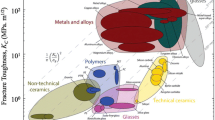Abstract
A model explaining the variability of oxygen solubility in the transition metals is proposed in this article. It assumes that the energy of solution can be represented as the sum of the work required to embed an oxygen atom in the electron gas of the host lattice, plus the energy generated through the formation of an oxygen anion. The latter term is treated as nearly constant across the transition metal series, leaving the work term to account for the observed variations in oxygen solubility. This work, we argue, can be approximated by the ratio of the number of metal electrons excluded from the region around the oxygen atom to the Fermi energy density of states. In turn, the number of electrons excluded by oxygen is assumed to be proportional to the charge density at the octahedral interstitial site. These assumptions allow us to define a solubility parameter that is easily determined with first-principles methods. This parameter is shown to correlate well with experimental findings regarding oxygen solubility in transition metals. Supported by these findings, we use first principle methods to identify alloying elements likely to reduce the solubility of oxygen in niobium.
Similar content being viewed by others
References
W. Hume-Rothery, G.W. Mabbott, and K.M. Channel-Evans: The freezing points, melting points, and solid solubility limits of the alloys of silver, and copper with the elements of the B sub-groups. Philos. Trans. R. Soc. A 233, 1 (1934).
W. Hume-Rothery and G.V. Raynor: The Structure of Metals and Alloys, Monograph No. 1 (Institute of Metals, London, U.K., 1983).
G.P. Tiwari and R.V. Ramanujan: The relation between the electron to atom ratio and some properties of metallic systems. J. Mater. Sci. 36, 271 (2001).
G.B. Olson, A.J. Freeman, P.W. Voorhees, G. Ghosh, J. Perepezko, M. Eberhart, and C. Woodward: Quest for noburnium: 1300C cyberalloy, in International Symposium on Niobium for High Temperature Applications, edited by Y-W. Kim, and T. Carneiro (TMS, Warrendale, PA, 2004), pp. 113–122.
R.T. Bryant: The solubility of oxygen in transition metal alloys. J. Less-Comm. Metals 4, 62 (1962).
A. Taylo and N.J. Doyle: The solid-solubility of oxygen in Nb and Nb-rich Nb-Hf, Nb-Mo and Nb-W alloys: Part III. The ternary systems Nb–Mo–O and Nb–W–O. J. Less-Comm. Metals 13, 338 (1967).
Binary Alloy Phase Diagrams, edited by J. Murray, L. Bennett, and H. Baker, (American Society for Metals, Metals Park, OH, 1986).
J.W. Davenport: Linear augmented-Slater-type-orbital method for electronic-structure calculations. Phys. Rev. B 29, 2896 (1984).
G.W. Fernando, J.W. Davenport, R.E. Watson, and M. Weinert: Full-potential linear augmented–Slater-type-orbital method. Phys. Rev. B 40, 2757 (1989).
C. Fonseca Guerra, J.G. Snijders, and E.J. te Velde Baerends: Towards an order-N DFT method. Theor. Chem. Acc. 99, 391 (1998).
S.J.A. van Gisbergen, J.G. Snijders, and E.J.J. Baerends: Implementation of time-dependent density functional response equation. Comput. Phys. Commun. 118, 119 (1999).
Author information
Authors and Affiliations
Corresponding author
Rights and permissions
About this article
Cite this article
Eberhart, M.E., Jones, T.E., Batchelder, M.A. et al. Structure property relationships in the design of alloy composition: Moving beyond electron to atom ratios. Journal of Materials Research 20, 1330–1335 (2005). https://doi.org/10.1557/JMR.2005.0167
Received:
Accepted:
Published:
Issue Date:
DOI: https://doi.org/10.1557/JMR.2005.0167




